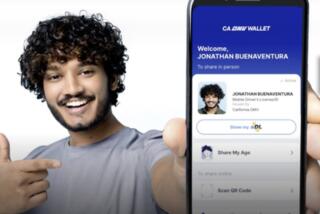Banks profit from fees paid by California welfare recipients
- Share via
SACRAMENTO — Millions of dollars in welfare benefits are ending up in banks’ pockets each year when poor Californians access their taxpayer-funded benefits, according to state statistics and a report released Tuesday.
Like many other states, California issues electronic cards to welfare recipients so they can withdraw public assistance from ATMs. Last year, $18.9 million was spent on ATM fees. The year before they topped $19.4 million.
The state welfare system allows recipients to make four free withdrawals per month at ATMs run by MoneyPass, part of U.S. Bank. But they are more likely to use an ATM owned by Bank of America, Wells Fargo or JPMorgan Chase, where they have to pay the $3 fee routinely charged to non-customers, the report said.
The fees account for only a sliver of the $3.1 billion in benefits paid out through the state welfare program, but they can add up for the 547,000 California families that receive benefits, leaving less money available for necessities such as food, clothing and rent. The average welfare payment is $463 per month, according to the state Department of Social Services.
“This is the public’s money that we have collectively decided to invest in low-income families,” said Andrea Luquetta of the California Reinvestment Coalition, a San Francisco-based advocacy organization that published the report on ATM fees. “Public investments are being redirected away from what we want it to do.”
Electronic cards are used by 96% of California welfare recipients, half of whom paid ATM fees in January, according to state statistics. Bank of America earned $3.6 million from welfare transactions in one year, the report said.
Illinois bars fees on the first two withdrawals at any ATM. A California bill that would have restricted surcharges was shelved in 2011; it was opposed by the California Bankers Assn. A spokeswoman for the group, Beth Miller, said “our goal has always been to be transparent” and welfare recipients are notified of any surcharges as they’re making a withdrawal.
Michael Weston, spokesman for the Department of Social Services, said the state is trying to teach welfare recipients about how to avoid ATM fees, including launching a pilot program last month in which thousands of Californians who have been paying surcharges receive telephoned warnings.
“We would like to maximize the limited resources for low-income families,” he said. “We’re trying to do that by educating them about how to find surcharge-free access.”
Welfare recipients can have payments deposited directly into bank accounts at no cost, but sometimes they can face other fees for overdrafts or low balances. Even when good options are available, they can distrust the banking system.
“It’s a major concern in the sense that working families should be able to keep the full extent of the benefits that are provided to them,” said Joe Valenti, who handles consumer finance issues at the Washington-based Center for American Progress.
One issue, Valenti said, is that the right ATMs are not always available where welfare recipients need them. There are roughly 2,500 MoneyPass ATMs in California, compared with 4,800 run by JPMorgan Chase and 3,800 from Bank of America.
State officials will have an opportunity to address the issue next year, when its current contract for managing the welfare payment system is scheduled to expire. The system is now run by Xerox State and Local Solutions Inc., which has another contract with MoneyPass that allows for some free ATM withdrawals.
Access to ATMs will be “an important factor in negotiations,” Weston said.
Twitter: @chrismegerian
More to Read
Sign up for Essential California
The most important California stories and recommendations in your inbox every morning.
You may occasionally receive promotional content from the Los Angeles Times.










